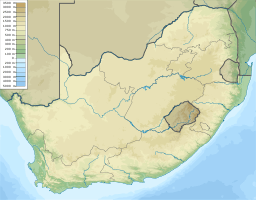Levubu River
| Levubu River (Levuvhu) | |
| River | |
| The Levubu River in Lanner Gorge, Pafuri | |
| Name origin: Either from the Venda Muvuvhu (hippopotamus),[1] or Mvuvhu (Combretum kraussii), a species of tree growing on its banks[2] | |
| Country | South Africa |
|---|---|
| State | Limpopo |
| Part of | Limpopo River basin |
| Tributaries | |
| - right | Dzindi River Mutshindudi River Mutale River |
| Source | |
| - location | Soutpansberg |
| Mouth | Near Pafuri |
| - location | Limpopo River, South Africa-Mozambique border |
| - elevation | 203 m (666 ft) |
| - coordinates | 22°25′32″S 31°18′25″E / 22.42556°S 31.30694°ECoordinates: 22°25′32″S 31°18′25″E / 22.42556°S 31.30694°E |
| Length | 200 km (124 mi) |
| Basin | 4,826 km2 (1,863 sq mi) |
 Location of the Levubu River's mouth | |
The Levubu River or Levuvhu[3] (Tsonga: Rivubye; Venda: Luvuvhu)[1] is located in the northern Limpopo province of South Africa. Some of its tributaries, such as the Mutshindudi River and Mutale River rise in the Soutpansberg Mountains.
The Luvuvhu River flows for about 200 km through a diverse range of landscapes before it joins the Limpopo River in the Fever Tree Forest area, near Pafuri in the Kruger National Park.[4]
A Zambezi shark (Carcharhinus leucas) was caught at the confluence of the Limpopo and Luvuvhu Rivers in July 1950. Zambezi sharks tolerate fresh water and can travel far up rivers like the Limpopo.[5]
Dams
- Albasini Dam
- Mambedi Dam
- Tshakhuma Dam
- Damani Dam
- Nandoni Dam, previously known as the Mutoti Dam, in the middle section of the Luvuvhu River east of the confluence with the Dzindi River tributary and east of the town Thohoyandou[6]
- Vondo Dam in the Mutshindudi River, a tributary
- Phiphidi Dam in the Mutshindudi
See also
- Drainage basin A
- List of rivers of South Africa
- List of reservoirs and dams in South Africa
- Luvubu and Letaba Water Management Area
References
- 1 2 Jenkins, Elwyn (2007), Falling into place: the story of modern South African place names, David Philip Publishers, p. 75
- ↑ du Plessis, E.J. (1973). Suid-Afrikaanse berg- en riviername. Tafelberg-uitgewers, Cape Town. p. 265. ISBN 0-624-00273-X.
- ↑ Olifants River now called Lepelle
- ↑ Latava and Luvuvhu River River Systems 2001, State of Rivers Report, WRC report no: TT 165/01, Water Research Commission, Pretoria, ISBN No: 1 86845 825 3
- ↑ Pienaar, U. de V., The Freshwater Fishes of the Kruger National Park, Koedoe Vol 11, No 1 (1968)
- ↑ Nandoni Dam - Description
This article is issued from Wikipedia - version of the 6/21/2016. The text is available under the Creative Commons Attribution/Share Alike but additional terms may apply for the media files.